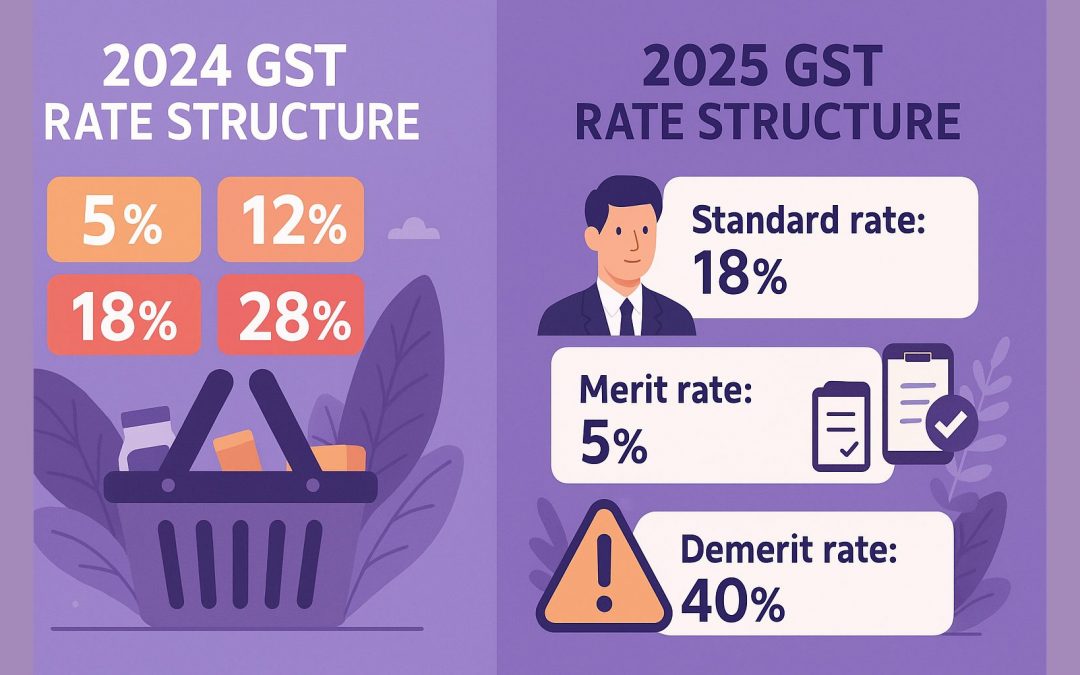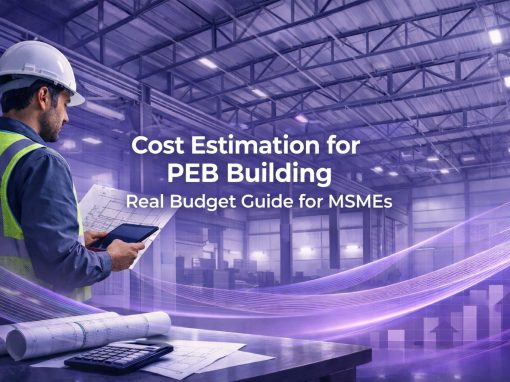Table of Contents
The Goods and Services Tax (GST) has been a gamechanger in the Indian tax system. A single, unified tax, GST does away with multiple indirect taxes. The GST structure is designed such that goods and services are taxed accordingly. It follows a 4-tier GST tax structure (as of 2024), where essential items are tax-free (NIL or 0% tax), while luxury items incur premium tax (28%).
Let’s take a look at the GST rate structure in India to understand how and why commodities are taxed in a certain way.
GST Structure in India
Before we delve into details of the GST rate structure of specific goods and services, here’s an overview of the GST structure in India as of 2024.
Update: The GST council meets on a regular basis to discuss and update GST rates on goods and services. Click below for the new GST rates 2025 list with updated GST rates.
Here is the link – New GST Rate List 2025: Updates, Comparisons, and Insights
For the full GST rates list, visit: //cbic-gst.gov.in/gst-goods-services-rates.html
| GST Tax Slab % | % of Items Included | Examples of Items Included |
| 0% tax or NIL taxes | 7% of items (all essential food items and services) | Milk, curd, natural honey, bread, eggs, newspapers, etc. |
| 5% tax | 14% of items | Packaged food, branded paneer, rusk, cashew nut, small restaurants, etc. |
| 12% tax | 17% of items | Dry fruits, fruit juices, spectacles, carom board, diagnostic kits, etc. |
| 18% tax | 43% of items (majority of items) | Ice cream, mineral water, IT services, telecom services, steel products, etc. |
| 28% tax | 19% of items (luxury items) | Dishwasher, automobiles, washing machines, personal care items, etc. |
Also read: GST on steel bars – Tax on iron, TMT bars and more
What is the GST Rate Structure?
The GST Council in India has designed a GST framework that categorises various goods and services and taxes them accordingly. Essential and daily use items are taxed less or are included under GST exempted items, while luxury items and high-value goods are taxed higher. Over 1300 goods and 500 services fall under this GST rate structure, which makes tax collections simpler and uniform.
As of 2024, there is a 4 tier GST tax structure: 5%, 12%, 18% and 28%
There is also the NIL or 0% rate of tax for specific essential items and food grains.
Gold is taxed at 3%, whereas precious and semi-precious stones are taxed at 0.25%.
What are the 4 Structures of GST?
As explained in the previous section, the GST regime in India has multi-tier tax structures to accommodate different goods and services. There are essentially 4 tax structures for GST: 5%, 12%, 18% and 28%
Nearly, 81% of all goods and services are taxed at or below 18% GST, with only 19% of goods being taxed at 28%.
Note: The GST structure refers to the tax slabs or tax rates and should not be confused with the different types of GST in India which refers to CGST, IGST, and SGST/UTGST.
How Many Structures are There in GST?
GST follows a multi-tier tax structures to ensure accommodation of a wide variety of goods and services. By and large, in India, the GST rate structure follows a 4-tier tax structure where GST on goods are taxed at 5%, 12%, 18% and 28% accordingly (as of 2024).
However, there are some essential items that are fall under the 0% GST tax structure (NIL), in which case, the GST structure is often referred to as the 5-tier GST structure: 0% (NIL), 5%, 12%, 18% and 28%
In the next section we will take a look at the individual GST tax structures and slabs.
Also read: GST on transport – Learn about GST slabs for transport systems
0% GST Tax Slab – Understanding the NIL Tax Category
There are several items categorised under the NIL or zero percentage tax bracket under the GST regime, to support daily sustainability and economic accessibility. These include (but are not limited to) food grains, healthcare services and educational materials, vital for everyday living.
| Category | Items with 0% GST |
| Food and Agriculture | Milk, eggs, curd, lassi, unbranded atta/maida, unpackaged food grains, hulled cereals, besan, gur, unpackaged natural honey, fresh vegetables, salt, meat, fish, etc. |
| Education | Education services, children’s drawing and colouring books, printed books, newspapers, etc. |
| Healthcare | Healthcare services, life-saving drugs, etc. |
| Transport/Hospitality | Hotels below ₹1000 tariff, vehicles that are handicapped-friendly etc. |
| Miscellaneous | Kajal, jhadoo, bangles, bindi, jute and handloom, etc. |
The exemption maintains affordability of essential goods, making it available to all without financial strain. It promotes welfare and sustainability and denotes the government’s commitment to ensure that basic needs of people are met.
5% GST Rate Structure – Products and Services
Next, let’s take a look at the 5% tax slab that covers basic goods and services that are above essential items. Items such as apparel under a certain value, packaged food items etc. fall under this bracket. In recent times, this category has been adjusted to include more items, reflecting changing consumer needs and market. This category is designed to balance affordability and revenue generation for the government.
| Category | Items with 5% GST |
| Food and Beverage | Tea, roasted coffee beans, sugar, edible oils, packed paneer, raisin, cashew nuts, baby milk food, spices, fish fillets, etc. |
| Apparel & Footwear | Footwear (less than ₹500), apparel (less than ₹1000), fabric, |
| Fuel | Coal, domestic LPG, PDS kerosene, fertilizers, etc. |
| Transport, Hospitality & Healthcare | Life saving drugs, medicine, rail and economy air travel, small restaurants (less than ₹50 lakhs turnover), etc. |
| Miscellaneous | Coir mats, agarbatti, floor covering, etc. |
This GST tax slab is designed such that it contributes to revenue generation while ensuring that basic goods are still affordable. It also ensures tax policies are adjusted based on public necessity and economic conditions.
Must Read: Takeaways from the 55th GST Council Meeting with Agenda Highlights
12% GST Tax Bracket – Key Insights
The 12% tax rate represents a middle ground in the GST structure. It consists of items that are more than basic, but not considered high-value and essential for maintaining a basic to average lifestyle and regular needs. The items in this category are significant in number and variety, reflecting the changes in India’s growing economy.
| Category | Items with 12% GST |
| Food and Personal Care | Butter, ghee, processed food, ketchup, sauces, almonds, fruit juice, pickle, jam, packed coconut water, dry fruits in packaged form, etc. |
| Apparel & Accessories | Apparel (above ₹1000), mobiles, umbrellas, etc. |
| Healthcare & Hygiene | Ayurvedic medicine, diagnostic kits, tooth powder, etc. |
| Transport & Hospitality | Non-AC restaurants, business-class air tickets, etc. |
| Miscellaneous | Computers, carrom board, sewing machine, etc. |
As can be understood, these items enhance the quality of life but do not qualify as luxury items.
18% Slab of GST Structure – The Majority Items
The 18% slab plays a significant role in the GST system. More than 40% of all goods and services are included in this tax slab. It is often considered the standard rate for several goods and services that are beyond basic and essential items and include electronic items, processed food, among other. This slab has also undergone changes over the years, with items being added, moved up or down the GST rate structure to accommodate changes in market and economic conditions.
| Category | Items with 18% GST |
| Personal Care | Hair oil, toothpaste, toiletries, soap, sanitary napkins, beauty products, etc. |
| Food and Beverage | Ice cream, corn flakes, biscuits, cakes, pasta, soup, condiment, baked goods, etc. |
| Services | IT services, telecom services, financial services, etc. |
| Electronics | Computers, printers, camera, speakers, television, etc. |
| Transport & Hospitality | AC restaurants (with liquor), restaurants in 5-star hotels, etc. |
| Miscellaneous | Capital goods, industrial intermediaries, steel products, aluminium foil, etc. |
This GST rate bracket includes a wide range of goods and services that are important in modern day living and is a key source of revenue generation for the GST system.
Also read: Impact of GST on logistics – How GST benefits the logistics sector
28% GST Tax Structure – Luxury Goods and Services
The slab for 28% tax is reserved for high-end goods and services and luxury items. It is the highest tax bracket in the GST structure in India and include goods that are desirable (e.g., high end cars, consumer electronics, etc.) and also whose consumption the government aims to deter (e.g., tobacco, aerated drinks, etc.).
| Category | Items with 28% GST |
| Luxury Automobiles | High-end motorcycles, high-speed cars, yachts, etc. |
| Consumer Electronics | AC, dishwashers, washing machines, fridge, etc. |
| Sin Goods | Tobacco, aerated drinks, pan masala, etc. |
| Entertainment | Sporting events, amusement parks, movie tickets (above ₹100), etc. |
This tax slab acts as both a revenue and regulatory tool and targets high-end products and goods that are considered unhealthy for consumption.
What are GST Features and Structures?
Now that we have understood the various GST rate structures and tax slabs, let’s understand the key features of the GST structure.
- GST is a multi-stage tax system that categories a wide range of goods and services and taxes them based on their nature and essentiality
- It enhances compliance, boosts transparency, and fosters an inclusive economy
- The unified GST tax structure consolidates central and state taxes into one and thereby reduces complexities
- GST structure is designed such that businesses can claim ITC paid on purchases of goods for production or resale, thereby preventing the cascading effect of taxes (Also read: GSTR 3B – GST returns form for ITC and taxes)
- GST registration is required for all eligible businesses (Also read: How to register on GST portal?)
- GST is a destination based tax that helps to redistribute tax revenue towards consumption-oriented states
Updated GST Rate List 2025
The new GST rate list for 2025 introduces significant updates aimed at simplifying compliance and boosting economic growth. India is now moving to a simpler two-slab system with rates of 5% and 18%.
- Standard rate: 18% – Applicable to most goods and services
- Merit rate: 5% – For essential items and priority sectors
- Demerit rate: 40% – Selective application to sin goods and luxury items
2025 GST Rate Reductions
| Category | Item Description | From (%) | To (%) |
| Daily Essentials | Hair Oil, Shampoo, Toothpaste, Toilet Soap Bar, Toothbrushes, Shaving Cream | 18 | 5 |
| Butter, Ghee, Cheese & Dairy Spreads | 12 | 5 | |
| Pre-packaged Namkeens, Bhujia & Mixtures | 12 | 5 | |
| Utensils | 12 | 5 | |
| Feeding Bottles, Napkins for Babies & Clinical Diapers | 12 | 5 | |
| Sewing Machines & Parts | 12 | 5 | |
| Uplifting Farmers & Agriculture | Tractor Tyres & Parts | 18 | 5 |
| Tractors | 12 | 5 | |
| Specified 12 Bio-pesticides and Micro-nutrients | 12 | 5 | |
| Drip Irrigation System & Sprinklers | 12 | 5 | |
| Agricultural, Horticultural or Forestry Machines (Soil Preparation, Cultivation, etc.) | 12 | 5 | |
| Healthcare Sector | Individual Health & Life Insurance | 18 | Nil |
| Thermometer | 18 | 5 | |
| Medical Grade Oxygen | 12 | 5 | |
| All Diagnostic Kits & Reagents | 12 | 5 | |
| Glucometer & Test Strips | 12 | 5 | |
| Corrective Spectacles | 12 | 5 | |
| 33 drugs and Medicines | 12 | Nil | |
| Agalsidase Beta, Imiglucerase and Eptacog Alfa Activated Recombinant Coagulation Factor VIIa Drugs | 5 | Nil | |
| Drugs and Medicines such as Faricimab, Pertuzumab, Fluticasone Furoate + Umeclidinium + Vilanterol FF/UMEC/VI, Ocrelizumab, and Brentuximab Vedotin | 12 | 5 | |
| Automobiles | Petrol & Petrol Hybrid, LPG, CNG Cars (≤1200cc & ≤4000mm) | 28 | 18 |
| Diesel & Diesel Hybrid Cars (≤1500cc & ≤4000mm) | 28 | 18 | |
| Three Wheelers | 28 | 18 | |
| Motorcycles (≤350cc) | 28 | 18 | |
| Motor Vehicles for Goods Transportation | 28 | 18 | |
| Education | Maps, Charts & Globes | 12 | Nil |
| Pencils, Sharpeners, Crayons & Pastels | 12 | Nil | |
| Exercise Books & Notebooks | 12 | Nil | |
| Eraser | 5 | Nil | |
| Electronic Appliances | Air Conditioners | 28 | 18 |
| Television (above 32″) (inc. LED & LCD TVs) | 28 | 18 | |
| Monitors & Projectors | 28 | 18 | |
| Dish Washing Machines | 28 | 18 |
2025 GST Rate Hikes
| Category | Item Description | From (%) | To (%) |
| Mining | Coal, Lignite, Peat | 5 | 18 |
|
Sin Goods |
Tobacco/ Pan Masala* | 28 | 40 |
| Aerated Waters | 28 | 40 | |
| Caffeinated Beverages | 28 | 40 | |
| Carbonated Beverages of Fruit drinks/with Fruit Juice | 28 | 40 | |
| Other Non‑alcoholic Beverages | 18 | 40 | |
| Motor Cars and Larger Hybrids (Beyond Small‑car Thresholds) | 28 | 40 | |
| Motorcycles Exceeding 350cc | 28 | 40 | |
| Aircraft for Personal Use | 28 | 40 | |
| Yachts and Vessels for Pleasure/Sports | 28 | 40 | |
| Smoking Pipes and Cigarette/Cigar Holders | 28 | 40 | |
| Revolvers & Pistols | 28 | 40 | |
| Admission to Casinos, Race Clubs, and Sporting Events like IPL | 28% with ITC | 40% with ITC | |
| Licensing of Bookmakers by Race Clubs | 28% with ITC | 40% with ITC | |
| Specified Actionable Claims (Betting, Casinos, Gambling, Horse racing, Lottery, Online Money Gaming) | 28% with ITC | 40% with ITC | |
| Leasing/rental without Operator of Goods Attracting 40% GST | 28% with ITC | 40% with ITC | |
| Paper Sector | Dissolving‑grade Chemical Wood Pulp | 12 | 18 |
| Various Papers/Paperboards, Other Than Exercise‑book Paper | 12 | 18 | |
| Textiles | Apparel/Made‑ups > Rs 2,500 per piece | 12 | 18 |
| Quilted/Cotton Quilts and Quilted Products More Than Rs.2,500 per Piece | 12 | 18 | |
| Paper | Uncoated paper and paperboard for exercise, graph, laboratory notebooks | 12% | Nil |
2025 GST NIL/Exempt Rate Items
| Sector | Item Description | Old Rate | New Rate |
| Education | Erasers | 5% | Nil |
| Printed maps, Hydrographic Charts, Atlases, Globes | 12% | Nil | |
| Pencil Sharpeners | |||
| Writing Instruments (Pencils, Crayons, Pastels, Drawing Charcoals, Tailor’s Chalk) | |||
| Notebooks (Exercise, Graph, Laboratory) | |||
| Food | UHT Milk, Pre-packaged Paneer, Pizza Bread, Khakhra, Chapati, Roti | 5% | Nil |
| Paratha, Parotta, and Other Indian Breads | 18% | Nil | |
| Health | Specific Recombinant Therapeutic Drugs (Agalsidase Beta, Imiglucerase, Eptacog Alfa) | 5% | Nil |
| Advanced Biotechnological Medicines (Onasemnogene, Mepolizumab, etc.) | 12% | Nil | |
| Life and Health Insurance | All Individual Health and Life Insurance Policies and Reinsurance | 18% with ITC | Exempt |
* Effective from 22 September 2025
Empowering MSMEs to grow smarter
Tata nexarc delivers powerful solutions for MSMEs—discover tenders, logistics solutions, and streamline procurement. Everything your business needs, all in one place.
At Tata nexarc we aim to enable MSMEs grow their business. We offer a wide range of reliable and affordable solutions on our platform and have partnered with leading sellers and service providers for the same. You can buy steel at the best prices, get logistics services, and more. To know more, register now on Tata nexarc.
FAQs
Sohini is a seasoned content writer with 12 years’ experience in developing marketing and business content across multiple formats. At Tata nexarc, she leverages her skills in crafting curated content on the Indian MSME sector, steel procurement, and logistics. In her personal time, she enjoys reading fiction and being up-to-date on trends in digital marketing and the Indian business ecosystem.










I own a bakery shop in Koramangala..Bread is tax-free, but cakes and pastries fall under the 18% GST slab. I try to balance the prices so that people can still afford a treat without breaking the bank…my advice is just plan your business objectives properly
We fall under the 18% GST slab, which is quite high for our industry. It does affect our pricing, but we try to balance it by offering quality service and unique experiences.
The multi-layered structure is better than previous system as it removes the cascading effect, which resulted in less write-offs, but I feel that the tax slabs could be a bit lesser, especially on consumables.
What is the technical difference between ‘GST Slabs’, ‘GST regime’, ‘GST Rates’, and ‘GST Structure’?
Pls guide.